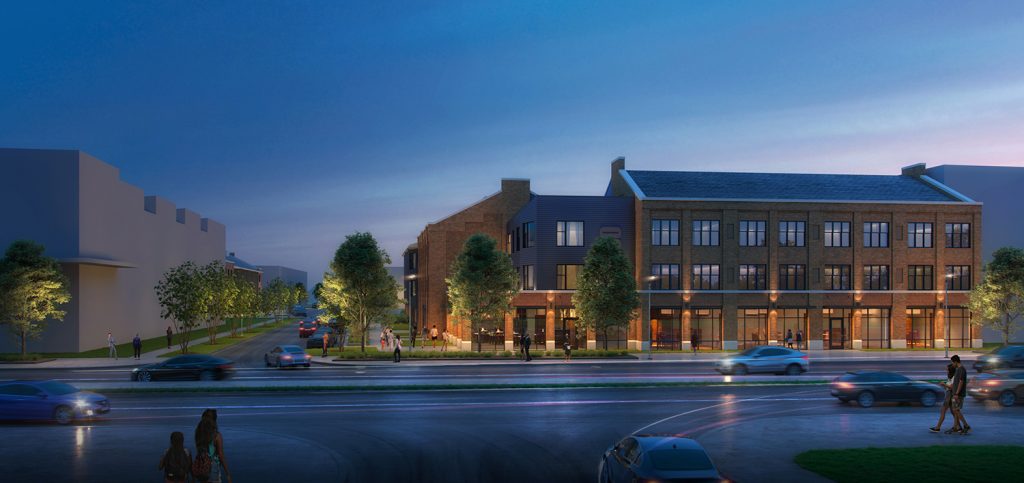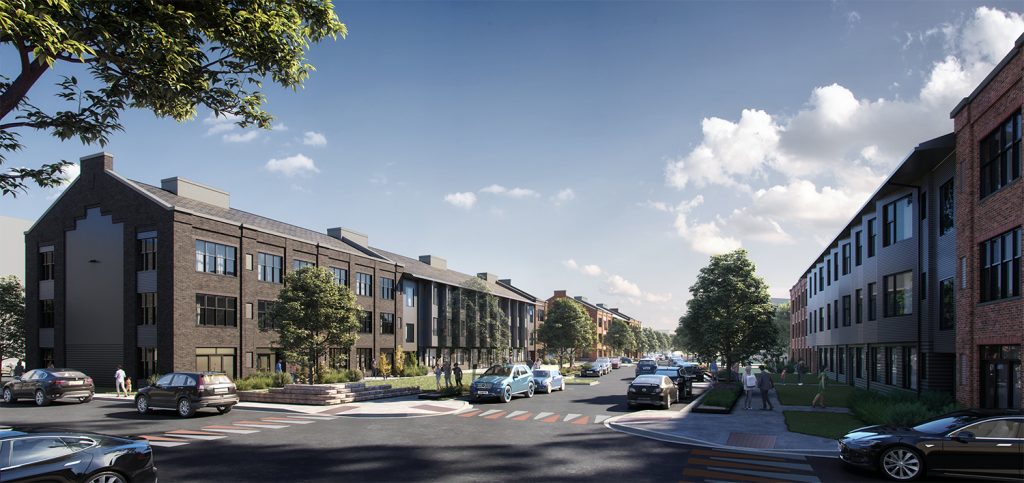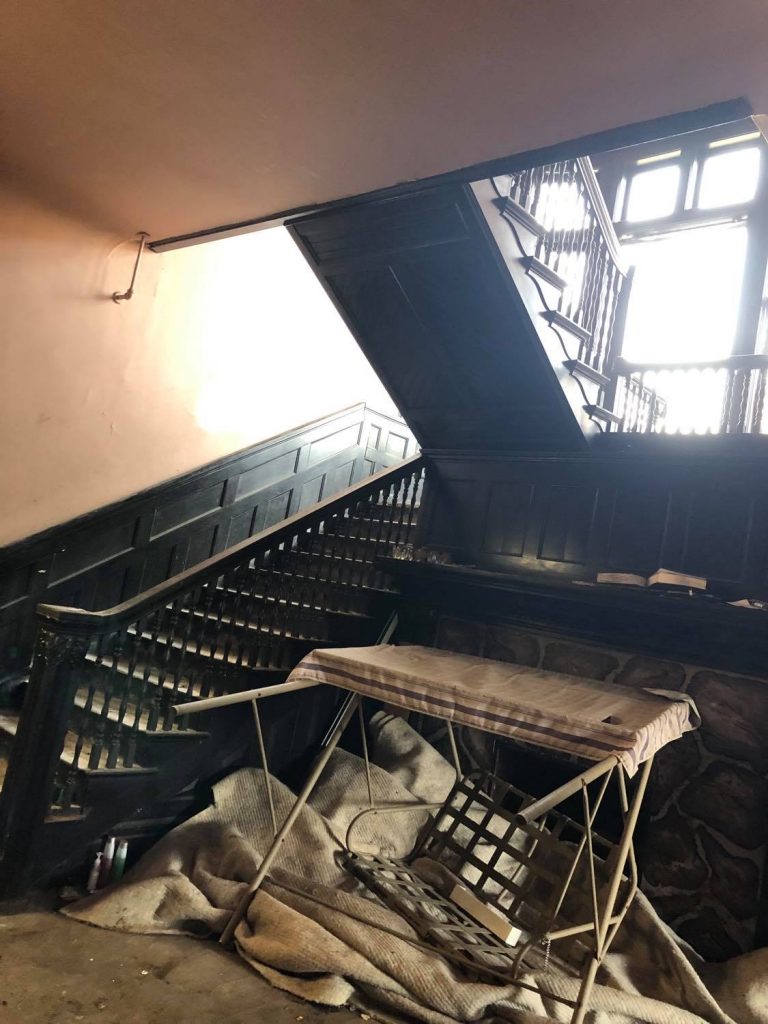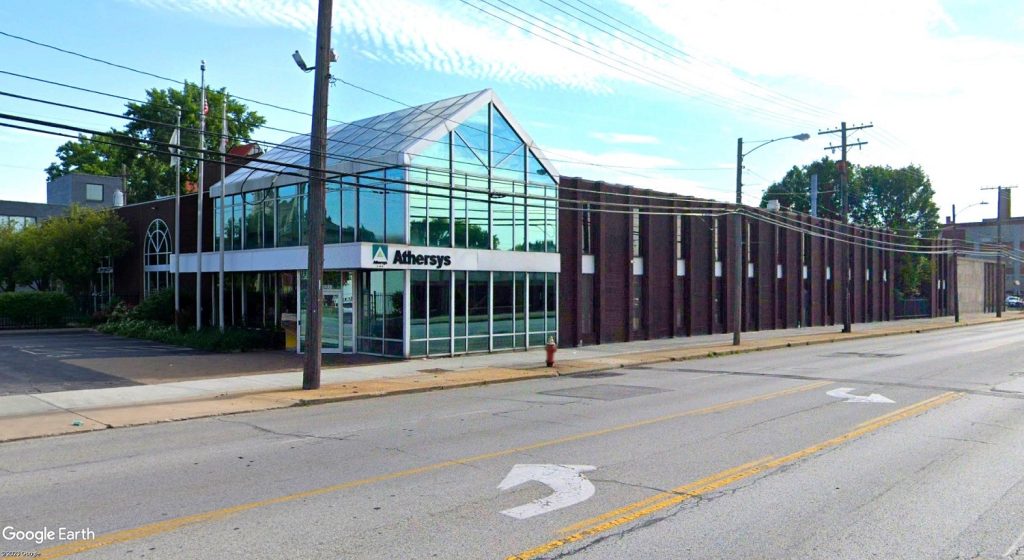
City Planning Commission is due to hear a demolition request in June for the historic Allen-Sullivan mansion, 7218 Euclid Ave. In its place, Signet LLC of Akron proposes to build a 160-unit residential complex on 6 acres extending south to Carnegie Avenue (ClevelandHistorical.org).
CLICK IMAGES TO ENLARGE THEM
Unless someone with deep pockets comes through in this 11th hour, the 134-year-old Allen-Sullivan mansion, 7218 Euclid Ave., will be the subject of a demolition request next month. According to a city official who did not want to be named publicly, a demolition permit application submitted on behalf of Signet Real Estate Group is scheduled to be heard June 4 by the City Planning Commission’s Design Review Committee.
Since NEOtrans broke the story last December that Signet Real Estate Group of Akron sought a mixed-use development on the site of the mansion, efforts were made to preserve the house. On Dec. 15, 2020, C&J Contractors of Cleveland submitted two demolition permits on behalf of Signet — one for the Allen-Sullivan house and another for a neighboring car repair shop at 7224 Euclid. A demolition permit was approved April 19 for the latter structure; crews are already razing it.
But the application for the Allen-Sullivan house was withdrawn by Signet at the city’s request. The developer gave the city three months to find a new user for the house, according to the source at City Hall. The city offered land on the other side of Euclid to relocate the house but couldn’t come up with the moving or re-establishment costs to encourage a developer to take on the project.
City estimates were $187,000 for moving the house and $180,000 for a new foundation, plus some additional expense for separating existing utilities from the house if Signet hadn’t done so by the time of the move. Additionally, renovations were estimated at anywhere from $1 million to $2.5 million depending on the proposed use and extent of restoration detail. The city offered redevelopment assistance to developers willing to take on the project. Several investors reportedly considered it but none could make the numbers work.
“I’m very disappointed that efforts to save this last battered Euclid Avenue Millionaire’s Row mansion have failed,” the city official said. “It (the house) needs a lot of work. We couldn’t find anyone to take ownership of the house and spearhead the renovations.”
Kathleen Crowther, president of the Cleveland Restoration Society, said preservation efforts were hampered by the decayed condition of the house. And, because the Allen-Sullivan house is not a designated Cleveland Landmark, there is no legal protection for it.
“Moving the Allen-Sullivan house is a tall order, an expensive proposition,” she said. “The only hope I see is if the city takes the lead on moving it and covers the expenses with assistance from the developer. Landmarks cannot be easily moved around like pieces on a chessboard. The abandonment of the building has made the prospect in saving it extraordinarily challenging.”
Signet acquired the mansion and nearly 6 acres of land in the 7200 block between Euclid and Carnegie avenues on Oct. 1, 2020 for $2.4 million, according to Cuyahoga County records. There, the developer proposes to construct up to five buildings containing market-rate apartments. The first phase is due to start construction in August with the three buildings closest to Euclid having an estimated construction cost of $27 million. An L-shaped building fronting Euclid is proposed to have a ground-floor, for-lease commercial space plus a community room for residents.
“Unfortunately, due to the condition of the house when we purchased it late last year and the length of time it had been neglected by the previous owner, most of the original materials have been previously removed or destroyed,” said Kevin Belt, Signet Real Estate Group’s senior vice president. “We are working to salvage any appropriate materials that remain and incorporate them into the new design, as well as allow an architectural salvage company to salvage any remaining materials to reuse or upcycle.”
Belt said Signet plans to utilize the foundation blocks from the house as landscape accents and walls throughout the new site. The interior wainscoting, the fireplace mantle and fireplace brick will be repurposed and used within the common areas of the new building as accent walls. In addition, the house will be documented to National Park Service historic preservation standards. Historic photos and a narrative of the home’s history will be created within the common area.
“We’re also exploring the idea of incorporating the entry gate from the project into the new site design, but haven’t identified the location yet,” he added. “Unfortunately the lion (above the entry gate) was gone when we purchased the property.”
Signet typically develops institutional structures such as for hospitals, universities and research centers plus carrying out public-private partnerships involving port facilities, sports stadiums and parking garages. But it also develops student housing for institutions of higher learning.
Its most recent housing project in Cleveland is the Axis at Ansel. Opening this nearly a year ago, the $35 million, 163-unit apartment building with more than 1,000 square feet of street-facing retail is located at the corner of Ansel Road and Hough Avenue. A retail tenant is Fawaky Burst smoothies. The market-rate apartments are 93 percent leased and there are waiting lists for studio and one-bedroom apartments.
“COVID was a bad thing but Case Western Reserve (University) probably helped us by having remote learning,” Belt said.
Students aren’t likely to be a target market for Signet’s MidTown Cleveland development. Instead, Belt anticipates it being attractive to young professionals working at Cleveland Clinic, biotech employers in MidTown, or downtown but without paying top-end rents common in University Circle or downtown. Monthly rents will start as low as $800.
According to the two demolition permit applications, the cost to raze the structures and remove their debris is estimated at $120,000. That includes the 14,300-square-foot auditorium/fraternal hall built in 1935 behind the 5,600-square-foot Allen-Sullivan mansion.
For two decades, the house and fraternal hall have sat unsed except for an on-site caretaker, wrote historian Jim Dubelko at ClevelandHistorical.org. The Queen Anne-style house was built in 1887 by railroad industry supplier Richard Allen and his wife Susan. As a widow, Susan Allen sold it in 1898 to Central National Bank founder Jeremiah J. Sullivan.
After the Sullivan family moved out, the mansion served from 1923-31 as an upscale furniture store called The Josephine Shop. In the midst of the Great Depression, the house was sold to the The Grand Lodge of Ohio, Order Sons of Italy in America which converted it in 1935 into an Italian-American fraternal hall. That’s when the auditorium was added onto the back of the house, Dubelko wrote.
In 1946, the fraternal organization sold the Allen-Sullivan mansion to the American Society of Heating and Ventilating Engineers. It operated offices and a research laboratory on the site until 1961, when the facilities were closed.
The property was sold again, this time in 1964 to Mary Fisco whose Italian immigrant husband Benjamin restored the house and auditorium to its appearance when it served as the Italian-American fraternal hall and operated it as The Colosseum Entertainment Center. Seven years after Benjamin Fisco’s 1992 death, the Colosseum closed and went through five ownership changes in the next 20 years, Dubelko wrote.
END













